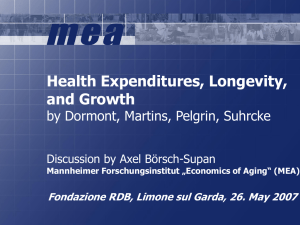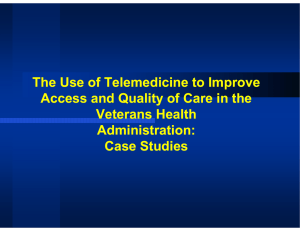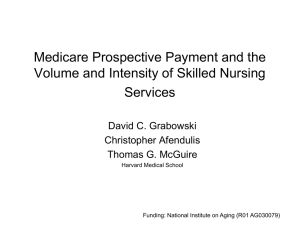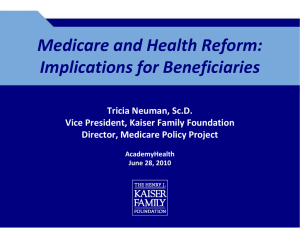Hongdao Meng, PhD, University of South Florida
advertisement
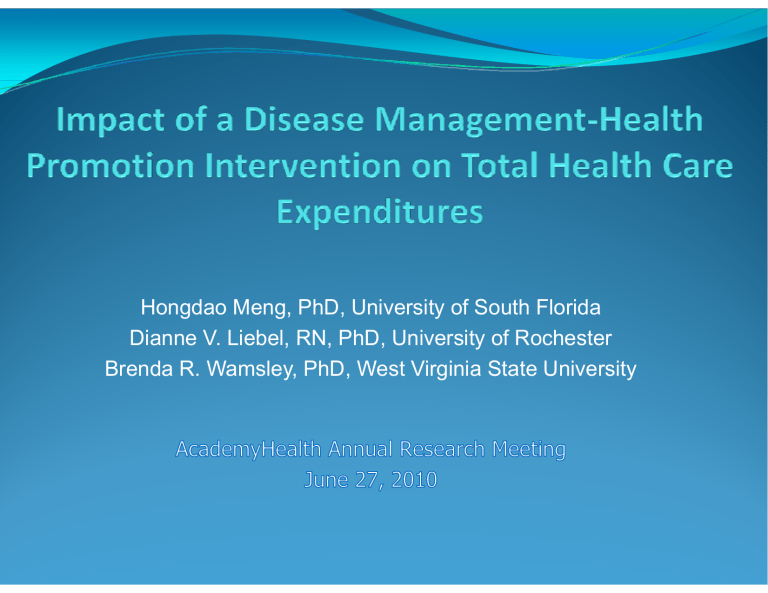
Hongdao Meng, PhD, University of South Florida Dianne V. Liebel, RN, PhD, University of Rochester Brenda R R. Wamsley, Wamsley PhD, PhD West Virginia State University Acknowledgements g Funding Agencies: Centers for Medicare and Medicaid Services (CMS) Office of Rural Health Policy/HRSA Research Team: Gerald M. M Eggert, Eggert PhD, PhD Director, Director Monroe County Long Term Care Program, Inc. Brenda R. Wamsley, PhD, Director, Center for Aging and Healthcare in West Virginia, Virginia Inc. Inc & West Virginia State University Bruce Friedman, PhD, University of Rochester David Oakes, PhD, University of Rochester T. Franklin Williams, MD, Monroe County Hospital Staff members at the two study sites: Dianne Liebel, RN, PhD, Ethan Corona,, PhD candidate,, Deanna Lewis,, MS,, Rowena Sizemore, MSW, and many others… Outline Background Rationale and Study Design Results: Total health care expenditures Discussion Di i Background Trend in aging and demographic change Aging of the baby boom generation and beyond. Trend in disability NHANES data d t suggested t d th thatt b both th ADL and d IADL disability increased between 1994‐2004 (Seeman 2010). The absolute number of individuals with d bl disabilities is expected d to increase. Background %p The 12% patients with 33+ chronic conditions accounted for one‐third of all Medicare spending. Evidence is mixed regarding the effectiveness and costs of disease management/health g / p promotion interventions Policymakers have been interested in: Ways y to improve p patient p outcomes Ways to rein health care expenditures The Medicare Demonstration Primary and Consumer‐Directed Demonstration (PCDC) A community‐based experiment: "A Randomized Controlled Trial of Primary and Consumer‐Directed Care for People with Chronic Illness. Illness ” $16 million over 4 y years (1998‐2002) 99 Two study sites: upstate New York and West Virginia/Ohio border Two interventions: Health promotion nurse (HPN) CLINTON FRANKLIN ST. LAWRENCE JEFFERSON ESSEX LEWIS HAMILTON WARREN WASHINGTON OSWEGO NIAGARA ORLEANS MONROE WAYNE ONEIDA HERKIMER FULTONSARATOGA GENESEE ONONDAGA ONTARIO MONTGOMERY CAYUGA SCHENECTADY MADISON RENSSELAER SENECA LIVINGSTON CORTLAND YATES SCHOHARIE ERIEWYOMING OTSEGO TOMPKINS ALBANY CHENANGO SCHUYLER ALLEGANY STEUBEN CATTARAUGUS CHAUTAUQUA COLUMBIA TIOGA CHEMUNG GREENE BROOME DELAWARE ULSTER DUTCHESS SULLIVAN PUTNAM WES CHESTER ROCKLAND ORANGE BRONX NEW NASSAU SUFFOLK YORK QUEENS KINGS RICHMOND Rationale for the HPN intervention Health promotion and disease management: The transtheoretical model (TTM) Stages of change (Prochaska & DiClemente 1992) Patient empowerment Self‐efficacyy enhancement (Bandura ( 1977) 977) Goals: Improve health and physical function Reduce demand for medical care Study Design 2 x 2 Factorial Design: Two factors (HPN ) Two T levels l l (Present (P t or Ab Absent) t) Sampling: Convenience sample from the communities Stages: Screening Randomization and enrollment Intervention Follow‐up p (at 22 months) Sample c us o C te a: Inclusion Criteria: Enrollment in Medicare Parts A and B Needing or receiving help for 2+ ADLs ADL (A (Activities ti iti off D Daily il Li Living) i ) or 3+ IADLs (Instrumental ADL) Recent health care utilization (ER, hospital, nursing home, or M di l h Medical home health) h lth) Exclusion Criteria: Living in a nursing home Enrollment in an HMO Enrollment E ll t in i M Medicaid di id h home and d community‐based it b d waiver i programs Receiving Medicare Hospice or End Stage Renal Disease (ESRD) benefits b fit The Intervention p Components of the HPN intervention: Patient education Monthly home visits Consumer Self‐Care Strategies and Health‐wise for Life handbooks Telephone consultation Individualized health promotion and disease self‐management self management coaching PRECEDE health education planning model (Green & Kreuter, 1991) Personalized goal‐setting Medication management Physician care management Physician‐Patient‐Caregiver‐Nurse Planning Conferences Snapshot Reports Community resources Data Baseline interview data Demographics: age, gender, ethnicity, education, income, marital status, informal caregiver status Health and functional status: status ADL ADL, IADL IADL, cogniti cognitivee status, SF‐36, number of chronic conditions Prior health care utilization Health care utilization data from a weekly diary Acute and post‐acute care: physician office visits hospital and ER visits (verified with providers) post‐acute nursing home visits (verified with providers) data on prescription drug use were not collected Long‐term care Outcome Measures: Total T l h health l h care expenditures di Statistical Analyses Cost outcome: Generalized Linear Model (GLM) Generalized Linear Model (GLM) p p The dependent variable is a member of the exponential family of distributions. E (Y ) g 1 ( X ) The variance of the dependent variable is a function of its mean. V (Y ) V ( ) V ( g 1 ( X )) Var Classical ordinary least squares model can be treated as a special case of GLM with identity link function. g ( ) GLM with log‐link. g ( ) ln(( ) Descriptive Statistics Table 1. Summary of Attrition Rate by Treatment Control HPN Initial Sample 384 382 Mortality 18% 18% Drop-out** 14% 20% ** P<0.01 Figure 1. Intervention (HPN) Effect on Monthly Total Expenditures† 1200 10411051 1000 Expenditures ($) 800 766 737 698 603 573 600 597 360 400 228 200 140 68 10 0 -30 -200 Prior Medicare Medicare -132 Non-Medicare -400 Control Intervention Medicare + Intervention Total Difference Note: Expenditure estimates were obtained from the predictions of the GLM model. The model adjusted for the following variables: intervention condition, age, gender, ethnicity, living arrangement, caregiver status, baseline ADL/IADL, cognitive status, angina, congestive heart failure, myocardial infarction, stroke, COPD, arthritis, diabetes, prior ER, hospital, nursing home and skilled home health care use, prior Medicare expenditures, BMI level, study site, and rural status. †: exclude expenditures on prescription medications Figure 22. Intervention (HPN) Effect on Monthly Expenditures, Expenditures by BMI Level 750 654 Expendittures ($) 550 350 261 105 87 150 00 111 100 71 -50 -250 -93 Underw eight -165 -252 Normal -72 -58 -62 Overw eight/obese -224 -341 -450 Prior Medicare Non-Medicare Total Medicare Medicare + Intervention Summary of Key Findings (HPN) The HPN intervention was cost neutral. The HPN intervention was associated with lower total expenditures among underweight beneficiaries. Limitations Attrition rate was high h h Regional sample, very few minorities Mixed results across different outcome measures Policy o cy Implications: p cat o s based experiments are time Large scale community community‐based time‐ consuming and resource‐intensive. Lack of ability to track patient across providers and care settings for fee‐for‐service beneficiaries The HPN intervention appeared to be effective in improving functional outcomes without increase totall health h l h care expenditures. di More M research h is i needed d d tto improve i the th design d i off health promotion & disease management interventions for Medicare beneficiaries with multi multi‐ morbidities.
